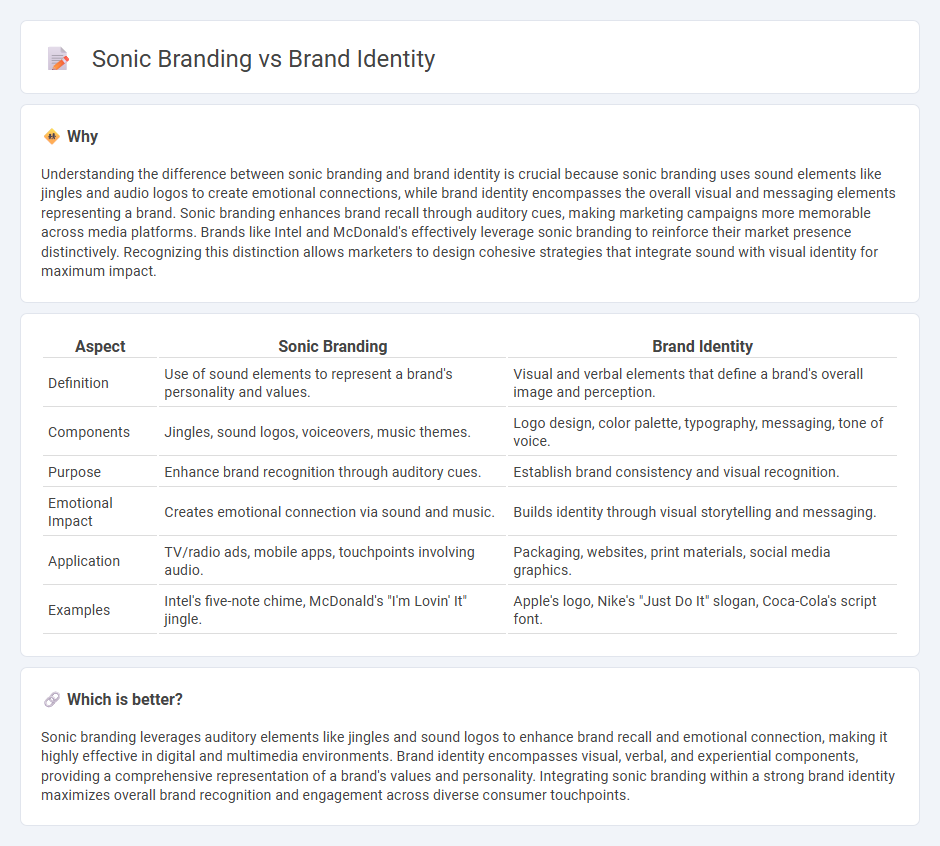
Sonic branding uses sound elements like jingles and audio logos to create a memorable brand experience, directly influencing customer perception and emotional connection. Brand identity encompasses visual components such as logos, color schemes, and typography to establish a consistent and recognizable presence across all platforms. Explore how integrating sonic branding with brand identity can amplify your marketing strategy and deepen customer engagement.
Why it is important
Understanding the difference between sonic branding and brand identity is crucial because sonic branding uses sound elements like jingles and audio logos to create emotional connections, while brand identity encompasses the overall visual and messaging elements representing a brand. Sonic branding enhances brand recall through auditory cues, making marketing campaigns more memorable across media platforms. Brands like Intel and McDonald's effectively leverage sonic branding to reinforce their market presence distinctively. Recognizing this distinction allows marketers to design cohesive strategies that integrate sound with visual identity for maximum impact.
Comparison Table
| Aspect | Sonic Branding | Brand Identity |
|---|---|---|
| Definition | Use of sound elements to represent a brand's personality and values. | Visual and verbal elements that define a brand's overall image and perception. |
| Components | Jingles, sound logos, voiceovers, music themes. | Logo design, color palette, typography, messaging, tone of voice. |
| Purpose | Enhance brand recognition through auditory cues. | Establish brand consistency and visual recognition. |
| Emotional Impact | Creates emotional connection via sound and music. | Builds identity through visual storytelling and messaging. |
| Application | TV/radio ads, mobile apps, touchpoints involving audio. | Packaging, websites, print materials, social media graphics. |
| Examples | Intel's five-note chime, McDonald's "I'm Lovin' It" jingle. | Apple's logo, Nike's "Just Do It" slogan, Coca-Cola's script font. |
Which is better?
Sonic branding leverages auditory elements like jingles and sound logos to enhance brand recall and emotional connection, making it highly effective in digital and multimedia environments. Brand identity encompasses visual, verbal, and experiential components, providing a comprehensive representation of a brand's values and personality. Integrating sonic branding within a strong brand identity maximizes overall brand recognition and engagement across diverse consumer touchpoints.
Connection
Sonic branding enhances brand identity by creating a distinct audio signature that reinforces visual and verbal brand elements. Consistent use of sound logos, jingles, or audio cues strengthens brand recognition, emotional connection, and recall across multiple touchpoints. Integrating sonic branding with visual identity builds a cohesive sensory experience that distinguishes a brand in competitive markets.
Key Terms
Visual Elements (for Brand Identity)
Brand identity emphasizes visual elements such as logos, color schemes, typography, and design style to create a recognizable and cohesive image for a company. These visual components establish brand recognition, evoke specific emotions, and differentiate the brand in competitive markets through consistent application across marketing materials and digital platforms. Explore how integrating sonic branding can complement visual identity to amplify brand impact.
Audio Logo (for Sonic Branding)
Brand identity encompasses the visual, verbal, and sensory elements that define a company's image, while sonic branding specifically targets the use of sound to create brand recognition. An audio logo, a concise and memorable sonic signature, plays a crucial role in sonic branding by reinforcing brand recall and emotional connection through carefully crafted melodies or sound motifs. Discover how integrating a compelling audio logo can elevate your brand's presence and deepen consumer engagement.
Consistency (relevant to both)
Brand identity and sonic branding both rely heavily on consistency to create a cohesive and recognizable experience across all touchpoints. Consistent use of visual elements, colors, fonts, and audio cues strengthens brand recognition and fosters trust among consumers. Explore how integrating these elements can elevate your brand presence and customer connections.
Source and External Links
What Is Brand Identity? - Brand identity is the unique set of characteristics that shapes a brand's personality, appearance, and emotional connection with its audience, helping it differentiate from competitors and build a lasting reputation through authenticity and consistency.
What Is Brand Identity? 6 Key Elements - Brand identity includes tangible design and messaging elements such as logo, color scheme, typography, voice, and tone that define a company's distinct personality and differentiate it in the marketplace.
What is brand identity? (and how to build one) - Brand identity combines visual elements like color palette and logo with voice and tone to represent a company's values, mission, and personality, serving as the "face" of the brand.
 dowidth.com
dowidth.com